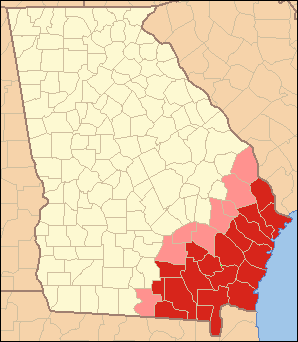Lower Coastal Plain (Georgia)

Southeast Georgia's Lower Coastal Plain is a subregion that encompasses the lowest-lying areas of the Atlantic coastal plain in the state, containing barrier islands, marshes, and swampy lowlands, as well as flat plains and low terraces.[1] It differs from Georgia's Upper Coastal Plain in that it is lower in elevation with less relief and wetter soils.[1] The United States Environmental Protection Agency defines the Lower Coastal Plain as an ecoregion, part of the larger, interstate Southern Coastal Plain.[1]
Within the subregion flow the major rivers the Altamaha, Ogeechee, Saint Marys, Savannah, Satilla, and Suwannee (all of which, except the Suwannee River, empty into the Atlantic Ocean); the Saint Marys and Suwannee rivers have their origins in the Okefenokee Swamp.
The subregion is synonymous with coastal Georgia,[2] and contains the counties of Atkinson, Bacon, Brantley, Camden, Charlton, Clinch, Echols, Glynn, Lanier, Pierce, Ware, and Wayne, south of the Altamaha River; and Bryan, Chatham, Effingham, Liberty, Long, and McIntosh, north of the Altamaha River.[1][3] The three metropolitan areas are those of Brunswick, Hinesville–Fort Stewart, and Savannah.[4] The largest census county divisions, in the order of decreasing population, are Savannah, Hinesville, Pooler–Bloomingdale, Brunswick, Saint Marys, Waycross, Jesup, Richmond Hill, Tybee Island, and Everett.[5] The total population of the eighteen-county subregion is 726,132 (286,271 south of, and 439,861 north of, the Altamaha River), as of the 2010 U.S. census.[5]
See also
References
- ^ a b c d Griffith, Glenn E., "Ecoregions of Alabama and Georgia" (PDF), United States Environmental Protection Agency, retrieved 2011-11-25,
75. Southern Coastal Plain (e-j)
{{citation}}:|format=requires|url=(help); Missing or empty|title=(help); Unknown parameter|coauthors=ignored (|author=suggested) (help) - ^ "Visit the Georgia Coast". The Georgia Coast Travel Association. Retrieved 2011-11-25.
- ^ Parts of Appling, Bulloch, Coffee, Evans, Jeff Davis, Lowndes, Screven, and Tattnall, counties, are located within the EPA-defined ecoregion.
- ^ "Population and Housing Occupancy Status: 2010 - United States -- Metropolitan Statistical Area". Bureau of the Census. United States Department of Commerce. April 14, 2011. Retrieved April 14, 2011.
- ^ a b "2010 Census Interactive Population Search" (Interactive). Bureau of the Census. United States Department of Commerce. Retrieved 2011-11-25.
External links
